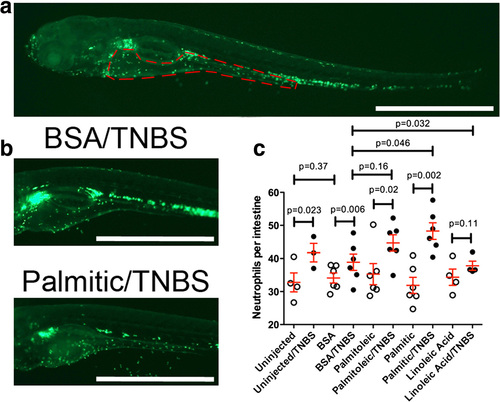- Title
-
CPAG: software for leveraging pleiotropy in GWAS to reveal similarity between human traits links plasma fatty acids and intestinal inflammation
- Authors
- Wang, L., Oehlers, S.H., Espenschied, S.T., Rawls, J.F., Tobin, D.M., Ko, D.C.
- Source
- Full text @ Genome Biol.
|
Fig. 5. Exogenous serum fatty acid exacerbates colitis in zebrafish larvae. aTg(lyzC:EGFP)nz117 larvae with red outline demarcating the edge of the intestine. Enhanced green fluorescent protein in these fish, under the control of the lysozyme C promoter, mark mature neutrophils, which are a marker of inflammation. b Representative images of Tg(lyzC:EGFP)nz117 larvae. Scale bar indicates 1 mm. c Quantification of intestinal neutrophils in 6 days post-fertilization (dpf ) zebrafish larvae exposed to 25–30 µg/ml TNBS from 3 dpf. Bar graphs are the mean ± standard error of the mean of six independent experiments (except uninjected and linoleic acid were from four independent experiments) with an average of 14.3 larvae evaluated in each group in each experiment. P values are from paired t-tests using the means of each group from each experiment. The number of total larvae evaluated in each group was: Uninjected, 48; Uninjected/TNBS, 45; BSA, 75; BSA/TNBS, 61; Palmitic acid, 91; Palmitic/TNBS, 93; Palmitoleic acid, 83; Palmitoleic acid/TNBS, 98; Linoleic acid, 50; Linoleic acid/TNBS, 70 |

